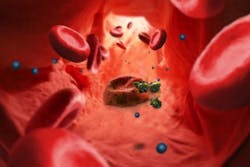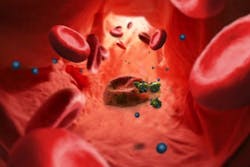Fluorescence microscopy aids in nanotechnology approach against malaria
Malaria parasites invade human red blood cells, then disrupting them and infecting others. Recognizing this, researchers at the University of Basel and the Swiss Tropical and Public Health Institute (both in Basel, Switzerland) have developed so-called nanomimics of host cell membranes that trick the parasites, then using fluorescence microscopy to observe their interaction. The work could lead to novel treatment and vaccination strategies in the fight against malaria and other infectious diseases.
Related: Laser optical tweezers show how malaria parasites invade red blood cells
Malaria parasites (Plasmodium falciparum, transmitted by the Anopheles mosquito) normally invade human red blood cells, in which they hide and reproduce. They then make the host cell burst and infect new cells. Using the research team's approach, this cycle can now be effectively disrupted: The egressing parasites now bind to the nanomimics instead of the red blood cells.
Researchers of groups led by Prof. Wolfgang Meier, Prof. Cornelia Palivan (both at the University of Basel), and Prof. Hans-Peter Beck (Swiss Tropical and Public Health Institute) have designed and tested host cell nanomimics. For this, they developed a simple procedure to produce polymer vesicles—small artificial bubbles—with host cell receptors on the surface. The preparation of such polymer vesicles with water-soluble host receptors was done by using a mixture of two different block copolymers. In aqueous solution, the nanomimics spontaneously form by self-assembly.
Usually, malaria parasites destroy their host cells after 48 hours and then infect new red blood cells. At this stage, they have to bind specific host cell receptors. Nanomimics are now able to bind the egressing parasites, thus blocking the invasion of new cells. The parasites are no longer able to invade host cells; however, they are fully accessible to the immune system.
The researchers examined the interaction of nanomimics with malaria parasites in detail by using fluorescence and electron microscopy. A large number of nanomimics were able to bind to the parasites and the reduction of infection through the nanomimics was 100-fold higher when compared to a soluble form of the host cell receptors.
Since many other pathogens use the same host cell receptor for invasion, the nanomimics might also be used against other infectious diseases.
Full details of the work appear in the journal ACS Nano; for more information, please visit http://dx.doi.org/10.1021/nn5054206.
-----
Follow us on Twitter, 'like' us on Facebook, connect with us on Google+, and join our group on LinkedIn
Subscribe now to BioOptics World magazine; it's free!

